I cleaned up the solder tabs of the equipment jacks in preparation for mounting on the switch frame. This evening I got into the mechanical work of the switch frame. First, I raised the lower row of switches by about five inches or so.

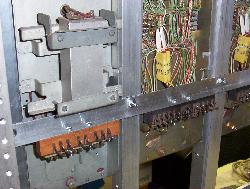
| Doug's SxS Switch -- The Early Days |
| 5 February -- a fair bit to report. Started disassembling a line finder bank, and since these particular banks date from the late 1940s, they were soldered rather than crimped like the
selector and connector banks, so they will take longer to take apart. I have 5 levels of the lower line bank apart so far. I cleaned up the solder tabs of the equipment jacks in preparation for mounting on the switch frame. This evening I got into the mechanical work of the switch frame. First, I raised the lower row of switches by about five inches or so. |
 |
| With that done I started building the equipment jack framework on the back. I found some "plywood edging" at the hardware store that appears to be perfect for mounting equipment jacks. Two equipment jacks (left and center) are now permanently mounted on the lower row. It's really beginning to look like a switch now! In the original full-size pic of this shot, I noticed the date code on the back of the old selector on the left - Feb 4 1942!! Happy 62nd Birthday Mr. Selector! |  |
 | 7 February -- A good day was spent at the switch frame. After work yesterday the upper switch row's equipment jack rail and jacks were mounted. Today the wiring of the jacks was begun. At this juncture, only battery, ground and release battery lines have been attached, but it is enough to be able to work with and troubleshoot the switches. Everything was nicely done on the jacks when I suddenly realized I had reversed the battery and release battery lines! Some remedial work with the soldering gun switched the leads around the way they should be. Wouldn't that have been interesting if left unnoticed and connected to the release battery alarm! |
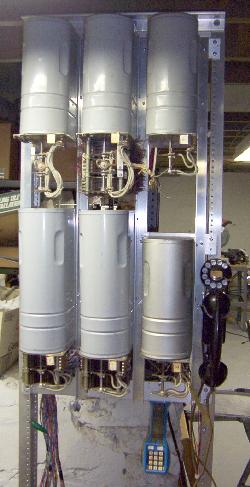 | Other work done on the frame today included the mounting of a 211 "Spacesaver" set on the right side, and the rewired connector banks
were attached to the connectors. With the banks in place the wipers of the connectors were adjusted to contact properly and testing of the connectors could take place. A lot of time was spent with the 30200 1942 selector (lower right, next to the phone). With new info in hand from a kind phone call from a fellow switcher I attempted to test the selectors. The newer 32077 digit absorbing selector worked as expected and appears to be wired to absorb digit "3" if dialed first. The 30200 was a different story. After a lot of puttering and dignosing it looks like the switch is not contacting the shelf jack correctly. I can't see how it contacts since the rail that holds the jack blocks the view of the contacts, and that older selector has quite a framework on the back of it to hold a large capacitor. More work will be needed with that. |
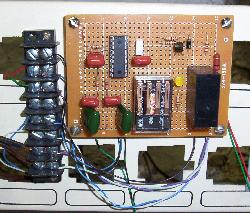 15 February - installed the tone/interrupter board on the switch frame, down at the bottom by the 48V power supply. Found that the second selector (the one in the middle of the bottom row) has some
contact issues. Seems like it doesn't take a lot of poking around with the relay contacts to render a problem of some kind in it. Among the problems encountered today were no release on disconnect because
the vertical off-normal contact that connects to the release magnet suddenly decided to not make correctly. Busy tone comes and goes with this selector because whatever contact that allows the "G" relay
to pull in doesn't always let it. Also had a problem with the "K" relay pulling in correctly due to contacts on the "H" relay being ornery. Running a slip of paper between the contacts to clean 'em up
seemed to make things worse rather than better! I'm open to suggestions on taming these ornery contacts.
15 February - installed the tone/interrupter board on the switch frame, down at the bottom by the 48V power supply. Found that the second selector (the one in the middle of the bottom row) has some
contact issues. Seems like it doesn't take a lot of poking around with the relay contacts to render a problem of some kind in it. Among the problems encountered today were no release on disconnect because
the vertical off-normal contact that connects to the release magnet suddenly decided to not make correctly. Busy tone comes and goes with this selector because whatever contact that allows the "G" relay
to pull in doesn't always let it. Also had a problem with the "K" relay pulling in correctly due to contacts on the "H" relay being ornery. Running a slip of paper between the contacts to clean 'em up
seemed to make things worse rather than better! I'm open to suggestions on taming these ornery contacts.
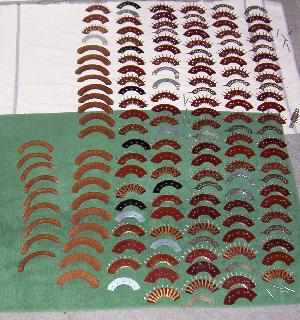 |
22 February -- Today I washed up all the wafers of the first cleaned up and unwired line finder bank. It was quite a job as the photo would indicate. With three contact banks in total there's over 150 separate parts
to have to deal with! They really needed the cleanup, however. While those pieces dried I started to unwire the banks for the second line finder. As of this wiring, the lowest line bank for that set has had its original wiring removed. I am thinking that with only implementing well less than 100 lines in this switch, I will wire up only the sleeve bank and the upper line bank for the finders. I will also wire them straight across rather than in a "slipped" configuration that would be more "correct" for a set of finders. Wiring slipped banks in a small switch with only two finders would not result in much of an advantage in terms of wait time for dial tone. At a future time I may be interested in working with the lower line banks but for now I won't be wiring them. |
| 28 February -- Spent the week working with the eBay ring generator board which arrived. There was no paperwork with it (nor expected) and after an evening of Internet searching some of the
basics of the board had been discovered. Namely, the board was not strictly a 48 volt input-ring power output supply, despite its eBay write-up. The board requires 20 VAC input, generates its own 48 VDC, converts that to ring power
output, and provides superimposed ring and trip power out. Sort of. Today the ring supply board was mounted on the switch frame in the lower area with the other power supplies and interrupter board. While the board does supply 20 Hz ring power, the trip supply appears to be a bit weak for a step switch. Answering a ringing station during the ring phase results in getting rung in the ear. During that situation you can hear the "F" relay trying to pull up in the connector, but it can't quite make it. It's not a big disappointment since it wasn't expected that this board would be supplying superimposed ring voltage. In contact bank work, the second line finder bank is still having its original wiring removed. | 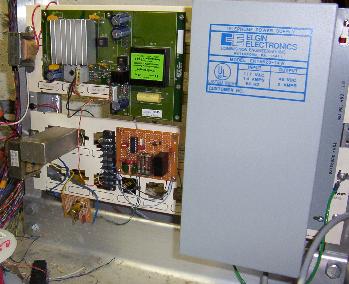 |
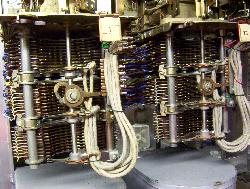 | 17 March -- A bout of snowy weather has work closed today, so what better time than to play step switch right now! The vertical commutators for the finder banks were wired up and attached to the banks, and then whole mess was attached to the finders. They went on fairly easily, though it did help to take the switches off the frame first, the banks set on the tops of the cans of the switches below and then the switches remounted and the banks bolted on. |
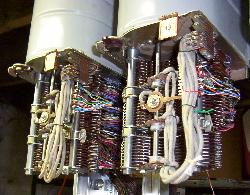 | Testing of the finders could now take place. There appears to be some dirty contact issues in the switches, not unexpectedly after what has happened so far with
the other switches. The functioning of the finders could still be tested and through the use of clip leads and some resistors simulated line finding could be done. There are
no line & cutoff relays here yet to actually have the finders search for a "real" line. The finders were wired to the selectors. The first finder was wired to the 1942 30200 selector, and the second finder was wired to the newer digit-absorbing selector. At the moment only the older selector has a contact bank attached so it is the only one currently that can have a complete call dialed through it. The next task is to strip, clean up and rewire the contact banks for the selectors. |
 | 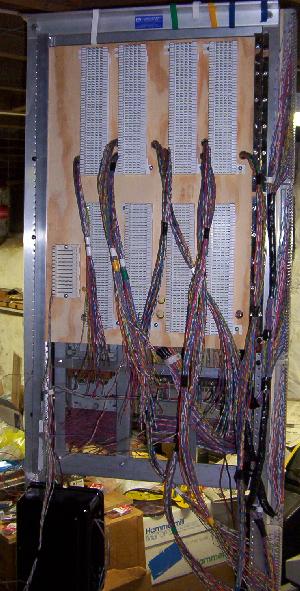 |
 | 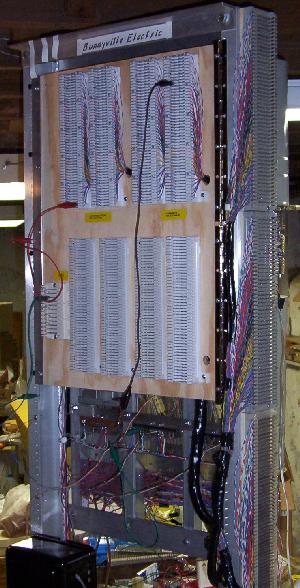 |